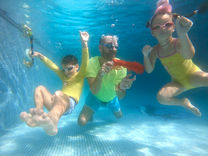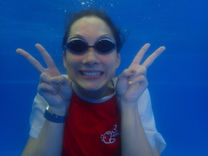How can we turn the resistance to swimming into a successful cooperation?
The same way school and kindergarten represent a big change for a child, water and swimming are also a big unknown to some kids. If apart from the resistance to swimming and water there is a specific fear on the one hand, and a good communication between the parents and the coach, and the willingness to enrol a kid in a swim school, make him/her learn how to swim, enjoy and have fun on the other, these situations can be avoided with the joint efforts of both parents and the coach.
In my own experience in work with children of all ages, I can say that these are some of the ways how I have managed to make the adaptation of children easier, and deal with some difficulties, resistance to water and swimming, with the help of the parents.
How to make it easy for children to go to a swim school?
To start with, prepare your children for new circumstances, a new setting, swimming:
Tell them your own story about starting with swimming, what you liked most and why, an anecdote to boost their curiosity for swimming. Show them your photo in your swim trunks as a kid, or a photo taken at a swimming pool, or even better if you have a video. I believe those old photos carry their own secrets which will conjure up a picture of your own experience as a beginner in swimming.
Explain to your child that once he/she starts with a swim school, he/she is not expected to know how to swim or dive right away. Make it clear that all the kids in his/her group are there to learn how to swim, that there are no wrong steps. Tell him/her that he/she should always feel free to make questions when he/she finds something unclear, the same way he/she does in kindergarten or school... the most important thing is to listen to the coach very carefully, to relax and enjoy the learning itself.
Include your child in the process of preparation for a swim school: After the lead-in on swimming, go together to buy trunks, and let you child choose the ones he/she wants. Then make an arrangement with the coach to have the first class be the one when your child meets the coach. The thing I like to do with the kids when they come to their first class is to make them feel comfortable, give them the stopwatch and the whistle, and we measure the time of the "big" swimmers together. Once I get their attention, I would also give them a paper sheet and a pencil to draw the two of us at the pool. Luckily, a letter doesn’t blush, and here you can see if the child is ready to jump into the pool, or it will take some more stories to be told and support to be given before it happens. At the end of the class, I would let them keep my goggles until the next class just as a reward for their effort, since we would both need them the next class.
I agree that saying is one thing and doing another, but for every beginning and work with children, including swimming, a lot of talk is crucial, as well as being patient, putting effort and believing in them. So, if this method doesn’t work with you child from the very beginning, prolong it, together with the coach, so that you child could adapt to the new environment, water and swimming in the best way.
What should we do when a child refuses to swim, when he/she resists it? Turn the resistance into cooperation. When it comes to the resistance to swimming, it’s important to know there are no hidden fears of the water. I had situations when parents would bring their children who, once they stepped in the water, would start screaming without a specific reason, the children would literally yell, and it was obvious that the tension had been there, even before they came to the pool, at home, and in the car on their way to the pool. Parents feel awfully embarrassed of course, because at that point they become the centre of everybody’s attention, and the tension doesn’t go away. There’s no need for it. Everything can be sorted out:
In such situations, I would kindly ask the parents to leave their child, though it’s hard for them to do so, and turn around and leave the pool. Then we sit at the edge of the pool, I let the child scream and yell (I don’t feel embarrassed, it’s just a bit painful to my ears) and I continue with my class as nothing’s going on. After the second or third time, they realise that nobody is forcing them to do anything, and that all the things we’re doing in the pool are done as a play, with laughing and joy. Once we turn the tension into cooperation and trust, it’s easier to learn how to swim.
However, there are kids who start crying, or even become hysterical when their parents leave them at the pool. At such moments of hysteria, with the previous approval of the parents, when the nice methods and talks give no results, I simply jump with the kid into the cold water (waist-deep). Yes, to get the things going and refresh, and believe it or not, the crying stops. To do this, it’s crucial that the parents trust the coach.
Of course, there were those cases when we all "ran" after a child around the pool, and outside. In those case we install the platform (an island) into the pool so that children who are not very tall can stand in the deep water. It is put away from the pool’s edge so that the kids who don’t swim cannot "run away" from the class. There were those who, even though they knew they couldn’t swim, would go off the island to realise very soon that it was much safer for them to stay on it. Once they realise it, it is easier. At that point, the entire class is focused on the work on the island and around it, with lots of props and toys in the water. And Bob’s your uncle, the crying and resistance stop, and the child eventually becomes engaged in the class, and starts accepting the water.
The boy who is the hero of this example is now a proud member of our competing team. He is also one of the best examples of how resistance to swimming can be turned into a successful cooperation!
After all, swimming is not mandatory, in the way school is. If your child is not ready to jump into the water now, he/she will be ready to do it tomorrow, or in a month or two, or in a year. We all do things at our own pace. It’s important not to rush him/her just because his/her friend or sister started swimming, and we should not make him/her be afraid of the water.






















































Comments